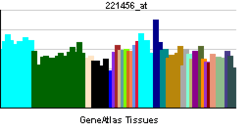TAS2R3
| TAS2R3 | |||||||||||||||||
|---|---|---|---|---|---|---|---|---|---|---|---|---|---|---|---|---|---|
| Identifiers | |||||||||||||||||
| Aliases | TAS2R3, T2R3, taste 2 receptor member 3 | ||||||||||||||||
| External IDs | MGI: 3606604 HomoloGene: 23231 GeneCards: TAS2R3 | ||||||||||||||||
| |||||||||||||||||
| RNA expression pattern | |||||||||||||||||
 | |||||||||||||||||
| More reference expression data | |||||||||||||||||
| Orthologs | |||||||||||||||||
| Species | Human | Mouse | |||||||||||||||
| Entrez | |||||||||||||||||
| Ensembl | |||||||||||||||||
| UniProt | |||||||||||||||||
| RefSeq (mRNA) | |||||||||||||||||
| RefSeq (protein) | |||||||||||||||||
| Location (UCSC) | Chr 7: 141.76 – 141.77 Mb | Chr 6: 40.49 – 40.49 Mb | |||||||||||||||
| PubMed search | [1] | [2] | |||||||||||||||
| Wikidata | |||||||||||||||||
| View/Edit Human | View/Edit Mouse |
Taste receptor type 2 member 3 is a protein that in humans is encoded by the TAS2R3 gene.[3]
Function
This gene encodes a member of a family of candidate taste receptors that are members of the G protein-coupled receptor superfamily and that are specifically expressed by taste receptor cells of the tongue and palate epithelia. These apparently intronless taste receptor genes encode a 7-transmembrane receptor protein, functioning as a bitter taste receptor. This gene is clustered with another 3 candidate taste receptor genes in chromosome 7 and is genetically linked to loci that influence bitter perception.[3]
See also
References
Further reading
- Kinnamon SC (2000). "A plethora of taste receptors". Neuron. 25 (3): 507–10. doi:10.1016/S0896-6273(00)81054-5. PMID 10774719.
- Margolskee RF (2002). "Molecular mechanisms of bitter and sweet taste transduction". J. Biol. Chem. 277 (1): 1–4. doi:10.1074/jbc.R100054200. PMID 11696554.
- Montmayeur JP, Matsunami H (2002). "Receptors for bitter and sweet taste". Curr. Opin. Neurobiol. 12 (4): 366–71. doi:10.1016/S0959-4388(02)00345-8. PMID 12139982.
- Adler E, Hoon MA, Mueller KL, Chandrashekar J, Ryba NJ, Zuker CS (2000). "A novel family of mammalian taste receptors". Cell. 100 (6): 693–702. doi:10.1016/S0092-8674(00)80705-9. PMID 10761934.
- Chandrashekar J, Mueller KL, Hoon MA, Adler E, Feng L, Guo W, Zuker CS, Ryba NJ (2000). "T2Rs function as bitter taste receptors". Cell. 100 (6): 703–11. doi:10.1016/S0092-8674(00)80706-0. PMID 10761935.
- Firestein S (2000). "The good taste of genomics". Nature. 404 (6778): 552–3. doi:10.1038/35007167. PMID 10766221.
- Matsunami H, Montmayeur JP, Buck LB (2000). "A family of candidate taste receptors in human and mouse". Nature. 404 (6778): 601–4. doi:10.1038/35007072. PMID 10766242.
- Ueda T, Ugawa S, Ishida Y, Shibata Y, Murakami S, Shimada S (2001). "Identification of coding single-nucleotide polymorphisms in human taste receptor genes involving bitter tasting". Biochem. Biophys. Res. Commun. 285 (1): 147–51. doi:10.1006/bbrc.2001.5136. PMID 11437385.
- Zhang Y, Hoon MA, Chandrashekar J, Mueller KL, Cook B, Wu D, Zuker CS, Ryba NJ (2003). "Coding of sweet, bitter, and umami tastes: different receptor cells sharing similar signaling pathways". Cell. 112 (3): 293–301. doi:10.1016/S0092-8674(03)00071-0. PMID 12581520.
- Fischer A, Gilad Y, Man O, Pääbo S (2005). "Evolution of bitter taste receptors in humans and apes". Mol. Biol. Evol. 22 (3): 432–6. doi:10.1093/molbev/msi027. PMID 15496549.
- Go Y, Satta Y, Takenaka O, Takahata N (2006). "Lineage-Specific Loss of Function of Bitter Taste Receptor Genes in Humans and Nonhuman Primates". Genetics. 170 (1): 313–26. doi:10.1534/genetics.104.037523. PMC 1449719
 . PMID 15744053.
. PMID 15744053.
This article incorporates text from the United States National Library of Medicine, which is in the public domain.